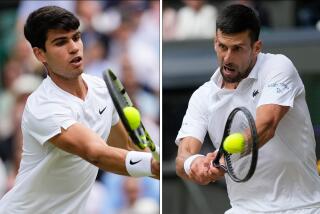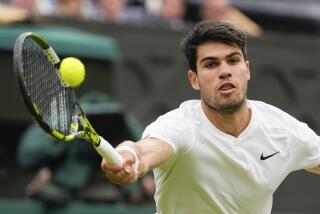Tennis : Grass Makes Things Unpredictable
- Share via
Much has been made of the falling of the top-seeded players in the men’s draw at this year’s Wimbledon. And a good thing, too, because without John McEnroe, tennis can use the excitement.
Except this business of upsets is really a non-issue. Why is it surprising that otherwise excellent players lose at Wimbledon?
Consider the surface. Grass is the least predictable of all tennis surfaces, and the least available for the majority of the world’s players. The number of grass courts is shrinking almost daily.
Even the venerable All England Lawn Tennis & Croquet Club has had to fight to keep its 30 grass courts from being plowed under, or worse, turned into a cricket pitch.
Money is a significant factor with grass courts. The care and feeding of world-class grass courts is extremely expensive. Grass, like most other living things, is sensitive to its environment. England’s fickle weather can wreak havoc on the gentle blades. A beating sun can burn and brown the grass and a sudden downpour not only suspends play but turns those bald spots into mud holes.
With the expense and trouble of grass, why not just slap down hard courts and repaint the lines a few times a year?
Tradition is strong at Wimbledon. Indeed, some would argue that tradition is Wimbledon. No amount of complaining from players about the condition of the courts--especially the outer courts where club members may hack away year round--is likely to bring about a change of surface.
Loud and long complaints were heard from the Australian Open last November. To hear the players tell it, the courts were more fit for a rodeo than professional tennis.
When the organizers went ahead with plans to move the tournament to a different site, a change from grass to a hard surface was discussed.
Think it would be a sacrilege to change the surface of a Grand Slam event? Too late. The precedent was set when the U.S. Open was moved from the grass of the West Side Tennis Club in Forest Hills to the hard courts at the U.S. National Tennis Center at Flushing Meadow.
Now about those seeded players losing. Ivan Lendl is the top seed in an event he has never won, no big surprise. Lendl was awarded the top seed because his dogs might have hurt someone if he wasn’t. Also because his record since winning last year’s U.S. Open is 75-3.
Yet Lendl is not a fearsome grass player. He admits he is not comfortable on the surface. In 1982 Lendl didn’t even enter Wimbledon, even though he was the No. 2 player in the world. He said at the time that he was allergic to grass. His record on grass since then has been nothing to sneeze at, but Lendl is happy to avoid the surface.
Second-seeded Mats Wilander has been to Wimbledon five times and never gotten past the round of 16. Like most Swedes, Wilander prefers the surface he grew up on--clay. He has struggled at Wimbledon.
No. 3 Jimmy Connors is already out of the tournament. No big surprise there. The ball bounces low on grass, and unpredictably. The game is fast. Thus a premium is put on agility and athleticism. Players must get low on shots.
At 33, Connors is certainly in the upper percentile for fitness in his age group, but that’s not enough against 18-year-olds with limitless energy.
Speaking of Boris Becker. . . so far, Becker is the best grass player on the list. Yet he is seeded fourth. Perhaps that’s because of a lingering injury to his palm. Or perhaps it’s because of his tender age and unpredictability. Still, he should be seeded higher.
Next to him, seeded fifth, is Stefan Edberg. Edberg is an excellent grass player, a serve-and-volley player. He’s the exception to the Swedes-live-at-the-baseline rule, but he was upset Saturday by Miloslav Mecir of Czechoslovakia.
Browsing through the top-seeded players you have to get to Tim Mayotte, No. 10, before you find another player noted for his play on grass. One of the world’s best grass players, Paul Annacone, isn’t even seeded in the top 16. Why be surprised when the No. 6 and No. 8 seeded players, Joakim Nystrom and Anders Jarryd, lose in the first or second rounds. This just isn’t their surface.
It’s more a shock when poor grass players, who happen to be seeded high, do win.
Grass is a very specialized surface. Of course, top players should be expected to cultivate all-court skills, but that doesn’t change the fact that all players have natural preferences in surfaces. No one was more surprised with Johan Kriek’s success at the French Open than Kriek himself. He despises playing on clay and never does well on the surface.
Still, even the grass-haters enter Wimbledon. It’s rare for top players to intentionally miss a Grand Slam event, McEnroe being the exception. So they enter and they lose and people shake their heads and talk about the upsets. Those players should take a hint from Lendl.
Keep off the grass.
Tennis Notes The Southland will leave its mark on the USTA Junior Davis Cup team this year. Three area players and two who attended school locally have been named to the team. Rich Leach of Laguna Beach has been named to the team for the third time. Leach, an All-American at USC, finished the collegiate season ranked No. 1 in both singles and doubles. Luke Jensen, who just completed his freshman year at USC, was named to the team for the second year. Also on the team are Brad Pearce of UCLA, Tim Trigueiro of Santa Barbara and UCLA, and Kelly Jones of San Diego and Pepperdine. . . . Noelle Porter of San Clemente will represent the West at the U.S. Olympic Festival, July 25-Aug. 3 in Houston. Also on the team are Mary Beth Young of La Habra and Lisa Green of San Jose. . . . The USTA National Junior Tennis League’s instructional tennis program will begin July 7 at 54 sites in Southern California. For information, contact Amy Gibbons at the Southern California Tennis Assn. at (213) 208-3838.
More to Read
Go beyond the scoreboard
Get the latest on L.A.'s teams in the daily Sports Report newsletter.
You may occasionally receive promotional content from the Los Angeles Times.











